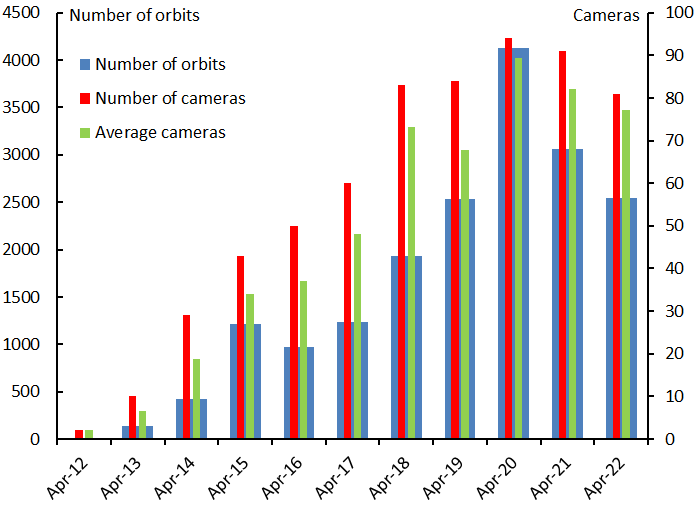Abstract: A summary of the activity of the CAMS BeNeLux network during the month of April 2022 is presented. This month was good for a total of 8363 multi-station meteors resulting in 2543 orbits.
Introduction
In April we welcome the first well-known meteor shower since the Quadrantids in early January, but in general meteor activity is still low for northern latitudes this month.
The month started with very poor weather, resulting in three successive nights with no simultaneous meteors at all on April 4, 5 and 6.
Weather improved after the first half of the month, so the Lyrid activity could be monitored very well from the BeNeLux.
April 2022 statistics
April 2022 showed two faces. During the first 10 nights observations at many stations were hampered by cloudy weather. During 7 nights in this period, we collected 493 orbits, a large part of this score during one clear night, April 2–3 with 144 orbits. After the first half of the month the weather improved and in this period we collected more than 2000 orbits.
CAMS-BeNeLux collected 8363 multi-station meteors this month, resulting in a total of 2543 orbits. Most meteors were of sporadic origin or from minor showers. Activity of the minor showers zeta Cygnids (ZCY, #0040), alpha Virginids (AVB, #0021) and mu Virginids (DLI, #0047) is clearly visible in the data.
In the second half of April, we see activity popping up from a few major showers too.
The first Lyrid meteor was captured by Martin Breukers (CAMS 321, Hengelo, NL) and Adriana and Paul Roggemans (CAMS 3832, Mechelen, BE) on April 14 at 23h36m26s UT.
The first eta Aquariïd meteor was captured by Klaas Jobse (CAMS 3033 and 3034, Oostkapelle, NL) and Robert Haas (CAMS 3165, Alphen aan de Rijn, NL).
The number of orbits derived from more than two stations was at a fairly high level of approximately 72.3%.
On average 77.2 cameras were active during the nights this month. This number is lower than last year (81.1), because for different reasons some stations were still not active at all this month.

Figure 1 – Comparing April 2022 to previous months of April in the CAMS BeNeLux history. The blue bars represent the number of orbits, the red bars the maximum number of cameras running in a single night and the green bars the average number of cameras running per night.
Table 1 – April 2022 compared to previous months of April.
| Year | Nights | Orbits | Stations | Max. Cams | Min. Cams | Mean Cams |
| 2012 | 6 | 11 | 4 | 2 | – | 2.0 |
| 2013 | 19 | 140 | 9 | 10 | – | 6.5 |
| 2014 | 19 | 421 | 12 | 29 | – | 18.8 |
| 2015 | 27 | 1212 | 15 | 43 | – | 33.9 |
| 2016 | 26 | 971 | 17 | 50 | 15 | 37 |
| 2017 | 28 | 1235 | 20 | 60 | 32 | 48.2 |
| 2018 | 27 | 1929 | 21 | 83 | 59 | 73.3 |
| 2019 | 29 | 2538 | 20 | 84 | 44 | 67.7 |
| 2020 | 29 | 4128 | 25 | 94 | 76 | 89.4 |
| 2021 | 28 | 3061 | 27 | 91 | 59 | 81.1 |
| 2022 | 27 | 2543 | 24 | 81 | 62 | 77.2 |
| Total | 265 | 18189 |
In May the stations at Ermelo and Zoersel are expected to deliver results again.
In Assenede (Belgium) a new camera was added to the network on April 14th by Günther Boerjan, Steve Rau and Paul Roggemans. This new RMS camera has been installed at the observatory “De Polderster” at Boekhoute (part of Assenede).
More new cameras will become active in the near future.
Conclusion
The results for April 2022 are the third best during 10 years of CAMS BeNeLux.
Acknowledgement
Many thanks to all participants in the CAMS-BeNeLux network for their dedicated efforts.
The CAMS BeNeLux team was operated by the following volunteers during the month of April 2022:
Hans Betlem (Woold, CAMS 3071, 3072 and 3073), Jean-Marie Biets (Wilderen, Belgium, CAMS 379, 380, 381 and 382), Ludger Boergerding (Holdorf, Germany, RMS 3801), Günther Boerjan (Assenede, Belgium, RMS 3823), Martin Breukers (Hengelo, Netherlands, CAMS 320, 321, 322, 323, 324, 325, 326 and 327, RMS 319, 328 and 329), Giuseppe Canonaco (Genk, RMS 3818, RMS 3819), Pierre de Ponthiere (Lesve, Belgium, RMS 3816 and 3826), Tammo Jan Dijkema (Dwingeloo, Netherlands, RMS 3199), Isabelle Ansseau, Jean-Paul Dumoulin, Dominique Guiot and Christian Walin (Grapfontaine, Belgium, CAMS 814 and 815, RMS 3814, RMS 3817), Uwe Glässner (Langenfeld, Germany, RMS 3800), Luc Gobin (Mechelen, Belgium, CAMS 3890, 3891, 3892 and 3893), Tioga Gulon (Nancy, France, CAMS 3900 and 3901), Robert Haas (Alphen aan de Rijn, Netherlands, CAMS 3160, 3161, 3162, 3163, 3164, 3165, 3166 and 3167), Robert Haas (Texel, Netherlands, CAMS 811, 812), Kees Habraken (Kattendijke, Netherlands, RMS 378), Klaas Jobse (Oostkapelle, Netherlands, CAMS 3030, 3031, 3032, 3033, 3034, 3035, 3036 and 3037), Carl Johannink (Gronau, Germany, CAMS 3100, 3101, 3102, 3103 and 3104), Reinhard Kühn (Flatzby, Germany, RMS 3802), Hervé Lamy (Dourbes, Belgium, CAMS 394 and 395, RMS 3825), Hervé Lamy (Humain Belgium, CAMS 816, RMS 3821), Hervé Lamy (Ukkel, Belgium, CAMS 393), Tim Polfliet (Gent, Belgium, CAMS 396, RMS 3820), Steve Rau (Zillebeke, Belgium, CAMS 3850, 3852, RMS 3851, RMS 3853), Paul and Adriana Roggemans (Mechelen, Belgium, RMS 3830 and 3831, CAMS 3832, 3833, 3834, 3835, 3836 and 3837), Hans Schremmer (Niederkruechten, Germany, CAMS 803).






